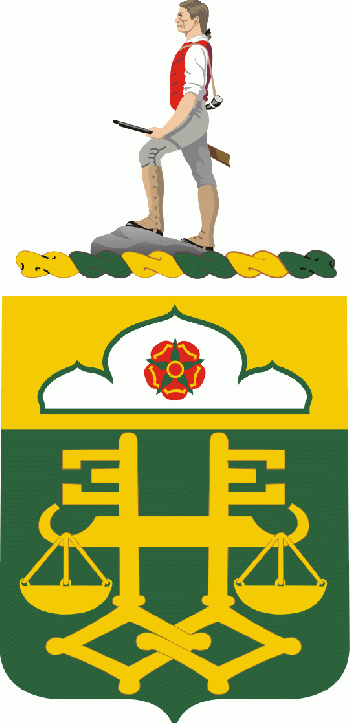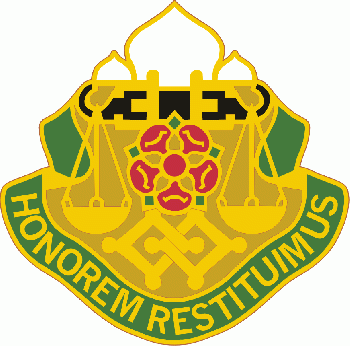160th Military Police Battalion, US Army
160TH MILITARY POLICE BATTALION, US ARMY
| (Coat of Arms) |
(Distinctive Unit Insignia) |
Official blazon
Shield: Vert, two keys palewise wards to chief addorsed with bows braced surmounted by a balance beam pendant of two pans Or, on a chief of the like the domes of Taj Mahal couped Argent, fimbriated of the first, charged with a heraldic rose Gules
Crest: That for regiments and separate battalions of the Army Reserve: From a wreath Or and vert, the Lexington Minute Man Proper. The Statue of the Minute Man, Captain John Parker (H.H. Kitson, sculptor) stands on the common in Lexington, Massachusetts
Motto: Honorem restituimus (We restore honor).
Distinctive Unit Insignia, Description: A gold color metal and enamel device 1 1/8 inches (2.86 cm) in height overall consisting of two erect gold keys addorsed and conjoined at the bows and surmounted at the center of the shanks by a red heraldic rose all in front of an between a pair of scales, the balance beam black and the scale pans gold and issuing above the balance beam a tapered white dome between the tops of two smaller domes (a representation of the Taj Mahal) all above agreen scroll, the ends curving inward behind the pendant supports the scale pans inscribed "HONOREM RESTITUIMUS" in gold letters.
Origin/meaning
Green and yellow are the colors used for Military Police. The two keys denote custody and restoration and, together with the scales of justice symbolize the organization's basic mission in the rehabilitation of military offenders. The rose alludes to the unit's sepecial award for outstanding devotion to duty. The Taj Mahal refers to the unit's service in India during World War II.
The arms were approved on 12 June 1996. The Distinctive Unit Insignia was approved on 21 January 1971.
Literature: The Institute of Heraldry, US Army.

